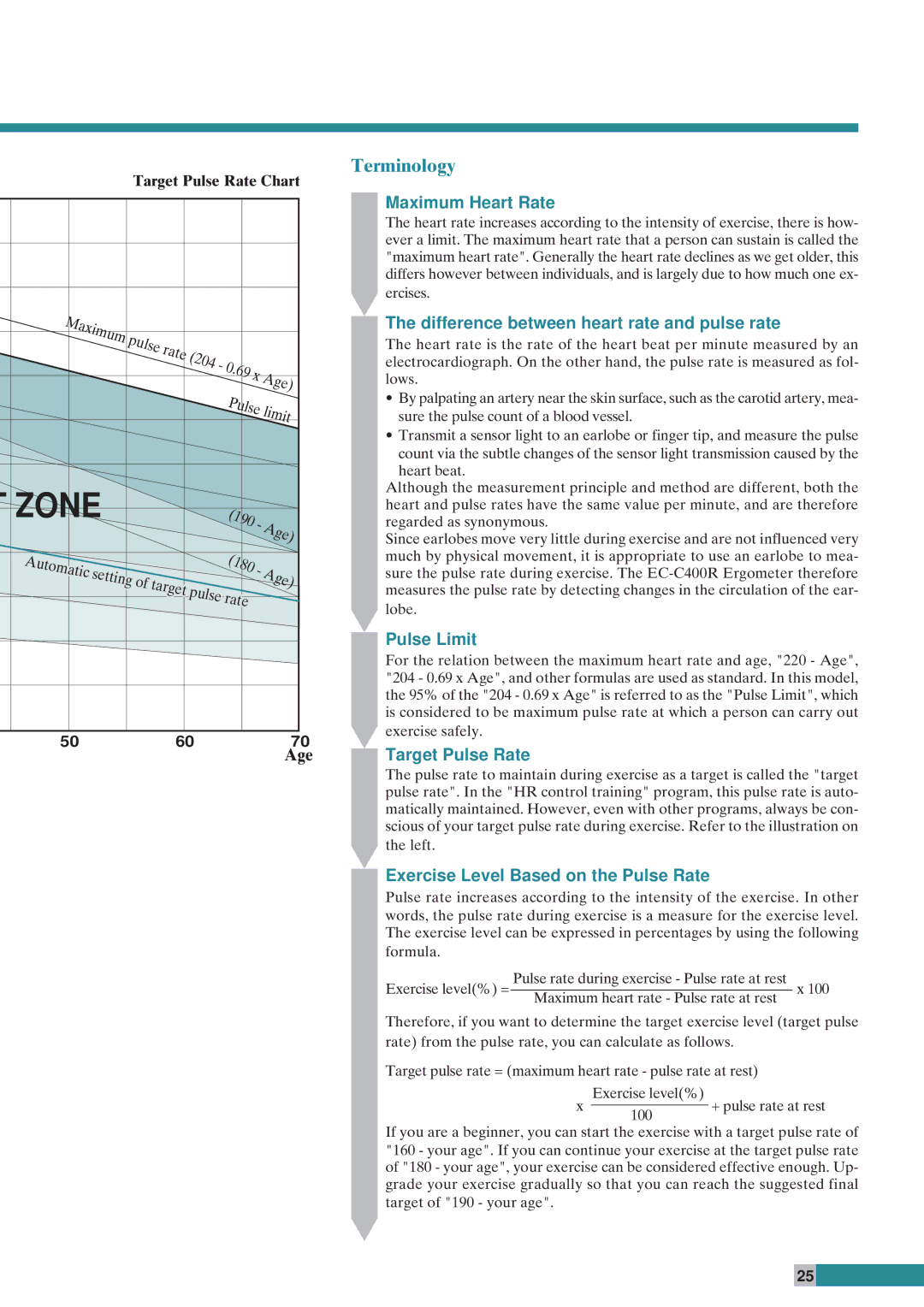
Target Pulse Rate Chart
Maximum | pulse |
|
|
| |
| rate |
|
| (204 - 0. |
|
| 69 x | |
|
| Age) |
| Pulse | |
|
| limit |
T ZONE |
| (190 | - | ||
|
|
| |||
|
|
|
|
| Age) |
Automatic | setting | of | (180 | - | Age) |
target |
| ||||
|
| ||||
|
|
|
| ||
|
|
|
|
| |
|
|
| pulse |
|
|
|
|
| rate |
|
|
50 | 60 | 70 |
|
| Age |
Terminology
Maximum Heart Rate
The heart rate increases according to the intensity of exercise, there is how- ever a limit. The maximum heart rate that a person can sustain is called the "maximum heart rate". Generally the heart rate declines as we get older, this differs however between individuals, and is largely due to how much one ex- ercises.
The difference between heart rate and pulse rate
The heart rate is the rate of the heart beat per minute measured by an electrocardiograph. On the other hand, the pulse rate is measured as fol- lows.
•By palpating an artery near the skin surface, such as the carotid artery, mea- sure the pulse count of a blood vessel.
•Transmit a sensor light to an earlobe or finger tip, and measure the pulse
count via the subtle changes of the sensor light transmission caused by the heart beat.
Although the measurement principle and method are different, both the heart and pulse rates have the same value per minute, and are therefore regarded as synonymous.
Since earlobes move very little during exercise and are not influenced very much by physical movement, it is appropriate to use an earlobe to mea- sure the pulse rate during exercise. The
Pulse Limit
For the relation between the maximum heart rate and age, "220 - Age", "204 - 0.69 x Age", and other formulas are used as standard. In this model, the 95% of the "204 - 0.69 x Age" is referred to as the "Pulse Limit", which is considered to be maximum pulse rate at which a person can carry out exercise safely.
Target Pulse Rate
The pulse rate to maintain during exercise as a target is called the "target pulse rate". In the "HR control training" program, this pulse rate is auto- matically maintained. However, even with other programs, always be con- scious of your target pulse rate during exercise. Refer to the illustration on the left.
Exercise Level Based on the Pulse Rate
Pulse rate increases according to the intensity of the exercise. In other words, the pulse rate during exercise is a measure for the exercise level. The exercise level can be expressed in percentages by using the following formula.
Exercise level(%) = | Pulse rate during exercise - Pulse rate at rest | x 100 | |
Maximum heart rate - Pulse rate at rest | |||
|
|
Therefore, if you want to determine the target exercise level (target pulse rate) from the pulse rate, you can calculate as follows.
Target pulse rate = (maximum heart rate - pulse rate at rest)
x | Exercise level(%) | + pulse rate at rest | |
100 | |||
|
|
If you are a beginner, you can start the exercise with a target pulse rate of "160 - your age". If you can continue your exercise at the target pulse rate of "180 - your age", your exercise can be considered effective enough. Up- grade your exercise gradually so that you can reach the suggested final target of "190 - your age".
25 ![]()
